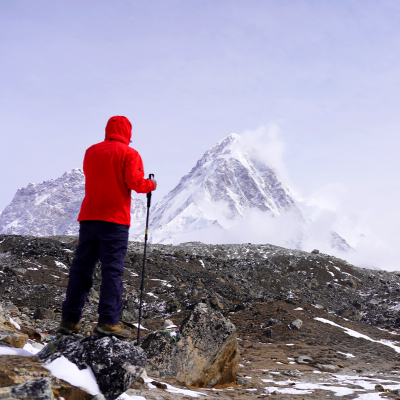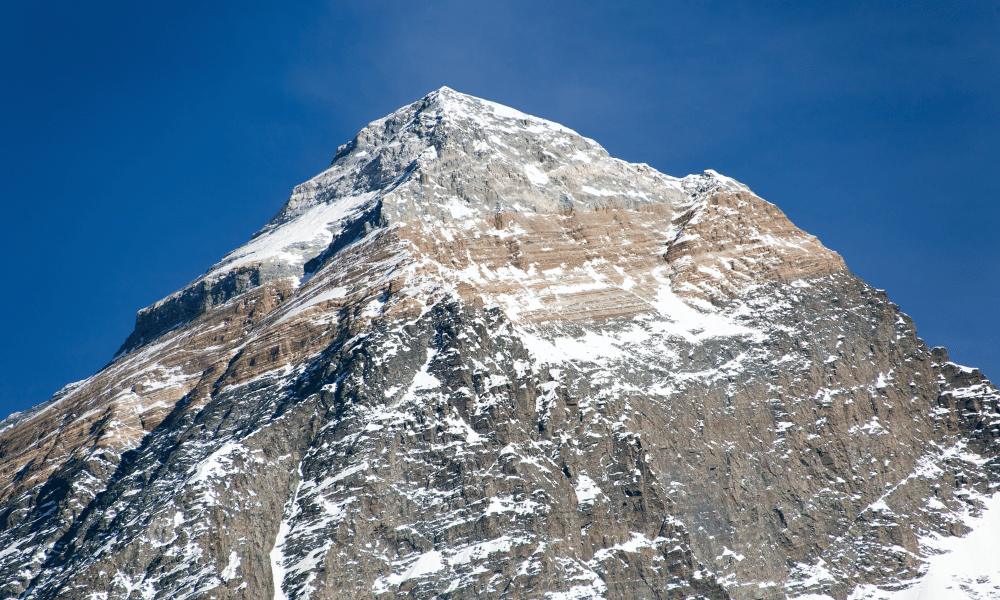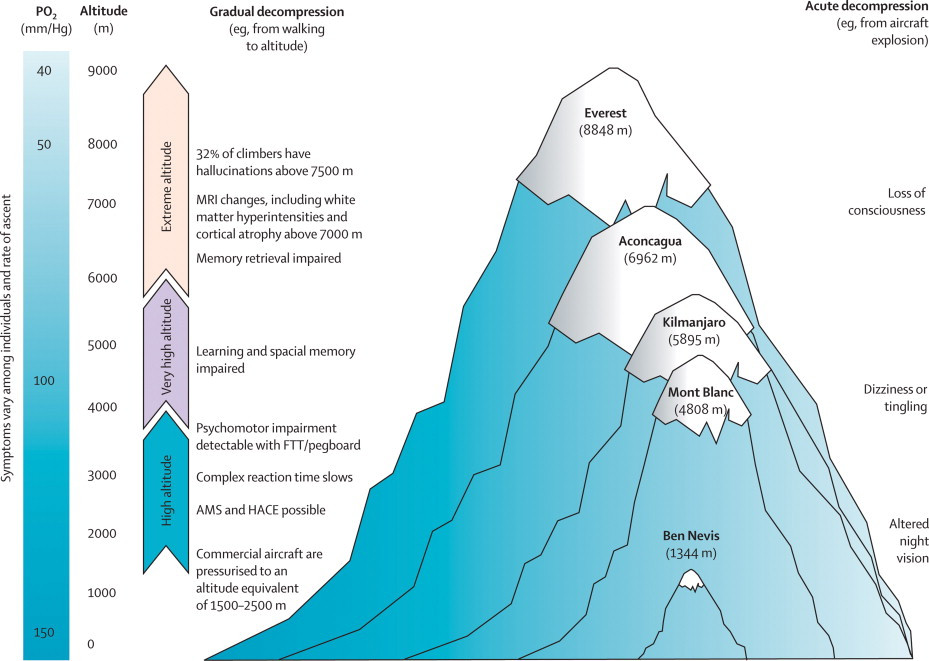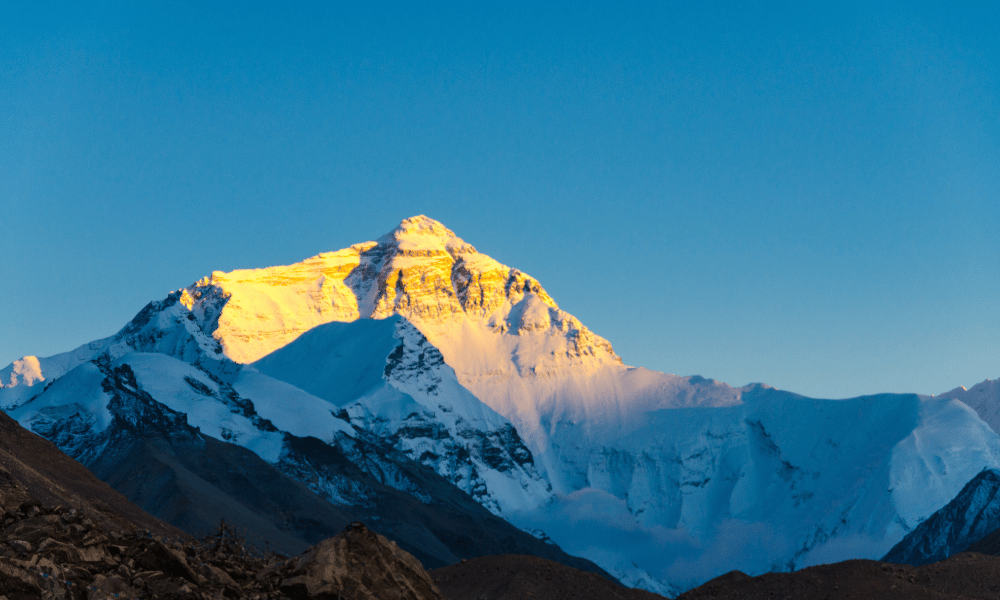Everest Death Zone
The Death Zone refers to the area on Mount Everest above 26,000 feet (8,000 meters) where the extreme altitude, low oxygen levels, and harsh weather conditions create a highly dangerous environment for climbers.
The Death Zone refers to the area on Mount Everest above 26,000 feet (8,000 meters) where the extreme altitude, low oxygen levels, and harsh weather conditions create a highly dangerous environment for climbers.


Mount Everest, the tallest peak in the world, stands at an impressive 29,032 feet (8,848 meters) above sea level. Located in the Himalayas on the border between Nepal and China, it has captivated the imaginations of mountaineers and adventurers for decades. Conquering Everest is often regarded as the ultimate achievement in mountaineering, attracting climbers from all over the world to test their skills, endurance, and perseverance against this formidable challenge.
The "Death Zone" refers to the area on Everest above 26,000 feet (8,000 meters), where the altitude, extreme weather, and treacherous terrain combine to create one of the most perilous environments on the planet. At this altitude, the air is extremely thin, containing only about a third of the oxygen available at sea level. As a result, the human body struggles to function properly, leading to a higher risk of life-threatening conditions such as hypoxia, cerebral edema, and pulmonary edema.
The term "Death Zone" was coined due to the significant number of fatalities that have occurred within this altitude range. The combination of low oxygen levels, harsh weather, and sheer exhaustion often proves to be lethal for climbers, even those with extensive experience and preparation. Consequently, the Death Zone is a stark reminder of the inherent dangers of climbing Mount Everest and the great risks that climbers undertake in pursuit of reaching the summit.
The Death Zone refers to the area on Mount Everest and other high peaks above 26,000 feet (8,000 meters), where the extreme altitude results in a significantly reduced oxygen supply and atmospheric pressure. These harsh conditions pose severe challenges to climbers, leading to altitude sickness, High Altitude Cerebral Edema (HACE), and High Altitude Pulmonary Edema (HAPE). Furthermore, the Death Zone presents additional risks, such as unpredictable weather, avalanches, falls, hypothermia, frostbite, and exhaustion, contributing to a high fatality rate. Despite its inherent dangers, the Death Zone continues to captivate climbers who seek to conquer the world's highest peak and test their physical and mental boundaries.
The Death Zone refers to the region on Mount Everest above 26,000 feet (8,000 meters). At this altitude, the conditions are extremely harsh, and the risk of life-threatening situations increases dramatically. It is named the "Death Zone" due to the significant number of fatalities that have occurred within this altitude range.
At the Death Zone's elevation, the atmospheric pressure is considerably lower than at sea level. This results in a significantly reduced amount of available oxygen. In fact, oxygen levels in the Death Zone are approximately one-third of what they are at sea level. The low atmospheric pressure also makes it difficult for the human body to effectively absorb and utilize the limited oxygen present in the air.

As altitude increases, the body struggles to adapt to the low oxygen levels and decreased atmospheric pressure. This can lead to a variety of altitude-related illnesses and conditions, including:
Acute Mountain Sickness (AMS): This is a common ailment experienced by climbers at high altitudes, characterized by headaches, nausea, dizziness, and shortness of breath.
High Altitude Cerebral Edema (HACE): This life-threatening condition occurs when fluid accumulates in the brain, causing swelling and potentially fatal neurological dysfunction. Symptoms include severe headaches, loss of coordination, confusion, and hallucinations.
High Altitude Pulmonary Edema (HAPE): Another life-threatening condition, HAPE results from fluid accumulation in the lungs, impairing oxygen exchange and leading to respiratory distress. Symptoms include shortness of breath, chest pain, coughing, and cyanosis (bluish discoloration of the skin).
In addition to these altitude-related illnesses, the body also experiences a decrease in overall physical performance, including reduced strength and endurance, slower reaction times, and impaired decision-making abilities. This makes it increasingly difficult for climbers to navigate the challenging terrain and extreme weather conditions found in the Death Zone.
The term "Death Zone" refers to the region on Mount Everest and other high-altitude peaks above 26,000 feet (8,000 meters), where the extreme conditions pose significant risks to human life. The oxygen levels in this zone are only about a third of what they are at sea level, making it extremely difficult for the human body to function effectively. The combination of low oxygen, reduced atmospheric pressure, and harsh weather conditions contributes to a high fatality rate among climbers. The name "Death Zone" underscores the perils of attempting to conquer these altitudes and serves as a stark reminder of the potential consequences for those who venture into this inhospitable environment.
The term "Death Zone" is believed to have originated in the 1950s when the first successful ascent of Mount Everest was achieved by Sir Edmund Hillary and Tenzing Norgay. The name reflects the extreme dangers and high fatality rate associated with climbing at such high altitudes. Over the years, the term has become widely used in mountaineering circles to describe the perilous region above 26,000 feet (8,000 meters) on Everest and other high peaks.
Since the first successful ascent of Everest, over 300 climbers have lost their lives attempting to reach the summit or during their descent. The Death Zone is responsible for a significant number of these fatalities. According to some estimates, approximately one in every 25 climbers who venture into the Death Zone will die. The fatality rate in the Death Zone is considerably higher than at lower elevations on the mountain, highlighting the extreme risks associated with climbing at such high altitudes.
Find some the the most common causes of death in the death zone:
Altitude sickness is a major cause of death in the Death Zone. Acute Mountain Sickness (AMS), High Altitude Cerebral Edema (HACE), and High Altitude Pulmonary Edema (HAPE) are common altitude-related illnesses that can prove fatal if not treated promptly. Symptoms include headaches, nausea, dizziness, shortness of breath, confusion, hallucinations, and loss of coordination.
The extreme cold in the Death Zone can cause hypothermia and frostbite, both of which can be life-threatening if not treated promptly. Hypothermia occurs when the body's core temperature drops dangerously low, leading to disorientation, impaired motor function, and, ultimately, organ failure. Frostbite results from the freezing of body tissues, often affecting extremities such as fingers, toes, and the nose. Severe frostbite can lead to gangrene and necessitate amputation.
Avalanches are a significant risk in the Death Zone, particularly in areas with heavy snow accumulation and unstable ice formations. Climbers can be swept away or buried by avalanches, leading to fatal injuries or suffocation. Falling is another major cause of death, as climbers may lose their footing on steep, icy terrain or experience equipment failure while traversing exposed sections of the mountain.
The strenuous nature of climbing in the Death Zone, combined with the low oxygen levels, can lead to extreme exhaustion and dehydration. Dehydration impairs the body's ability to regulate temperature and increases the risk of altitude sickness. Exhaustion can result in impaired decision-making, increased susceptibility to hypothermia, and an inability to continue climbing or descend to a safer altitude, potentially leading to a climber's death.
Climbing Mount Everest, the world's highest peak, presents a multitude of perils for even the most experienced climbers. The extreme altitude, low oxygen levels, and harsh weather conditions, including sudden storms and freezing temperatures, create a challenging environment that tests the limits of human endurance. Additional risks, such as avalanches, falls, hypothermia, and frostbite, further increase the dangers associated with climbing Everest. Moreover, overcrowding on the mountain can lead to bottlenecks and delays, exacerbating the risks for climbers. As the fascination with Everest continues, it is crucial for climbers to be well-prepared, respect the mountain, and understand the potentially life-threatening challenges they may face during their ascent.
Climbing Mount Everest presents numerous challenges, including the extreme and unpredictable weather conditions. The mountain's high altitude makes it prone to sudden and severe storms, which can bring hurricane-force winds, heavy snowfall, and whiteout conditions. These storms can trap climbers on the mountain, increase the risk of avalanches, and make navigating the treacherous terrain even more difficult. The short window of favorable weather for summit attempts also puts additional pressure on climbers to make quick decisions, potentially leading to mistakes and accidents.
Climate change has had a profound impact on Everest's glaciers, resulting in increased melting and the formation of unstable ice formations. This has made the climbing routes more hazardous, as climbers face a higher risk of avalanches, icefall, and collapsing seracs. Additionally, the melting glaciers contribute to the formation of dangerous crevasses, which can be difficult to detect and navigate. As climate change continues to affect the mountain, climbers are likely to face even greater challenges in the years to come.
The allure of climbing Everest has led to an increase in the number of climbers attempting the summit each year. This overcrowding can create dangerous bottlenecks on the mountain, particularly in the Death Zone, where the limited oxygen supply and extreme conditions make every minute count. Waiting in long queues at high altitudes puts climbers at greater risk of altitude sickness, hypothermia, and exhaustion. Furthermore, overcrowding can strain the mountain's resources, including the availability of experienced guides and the capacity of high-altitude camps.
The high fatality rate and extreme challenges associated with climbing Everest, particularly in the Death Zone, have raised ethical questions about the pursuit of summiting the world's tallest peak. Some argue that the risks involved are unnecessary and that climbers are putting their lives, as well as the lives of their guides and support staff, in danger for personal glory. Additionally, the environmental impact of climbing Everest, including the accumulation of trash and human waste on the mountain, has led to concerns about the sustainability and ethics of continued summit attempts. These ethical debates challenge climbers to consider the broader implications of their actions and whether the pursuit of the summit is truly worth the risks involved.

Survival in the Death Zone of Mount Everest requires a combination of careful preparation, proper acclimatization, and adherence to safety measures. Acclimatization, a gradual process of adjusting to the decreased oxygen levels and atmospheric pressure, is crucial for reducing the risk of altitude-related illnesses. Equipping oneself with appropriate gear, clothing, and supplemental oxygen is essential for facing the extreme conditions. Mental and physical fitness play a significant role in a climber's ability to make critical decisions and endure the challenging environment. Additionally, recognizing the symptoms of altitude sickness and seeking timely intervention can be lifesaving. Lastly, relying on the expertise of Sherpas, who possess invaluable knowledge of the mountain and climbing strategies, greatly enhances a climber's chances of a successful and safe summit attempt.
Importance of Acclimatization:
Acclimatization is the process of adapting to the decreased oxygen levels and lower atmospheric pressure at high altitudes. Proper acclimatization is crucial for climbers attempting to summit Everest, as it helps reduce the risk of altitude sickness and other altitude-related illnesses. It allows the body to gradually adjust to the harsh conditions in the Death Zone, improving climbers' chances of reaching the summit and returning safely.
Stages and Duration of Acclimatization:
Acclimatization typically involves a series of ascents and descents, allowing climbers to gradually expose themselves to higher altitudes before returning to lower elevations to recover. The process can take several weeks, depending on the individual and the specific climbing itinerary. Common stages include:
Arriving at base camp (17,600 feet) and spending several days for initial acclimatization
Climbing to Camp 1 (19,900 feet) and Camp 2 (21,300 feet), then descending back to Everest base camp
Ascending to Camp 3 (23,500 feet) before returning to lower camps or base camp
Finally, making the push for the summit from Camp 4 (26,000 feet) after adequate rest and acclimatization
Climbers must be equipped with appropriate gear and clothing to survive the extreme conditions in the Death Zone. Essential items include:
Insulated, waterproof clothing (jackets, pants, gloves, and hats)
High-quality mountaineering boots with proper insulation
Crampons and ice axes for navigating icy terrain
Harnesses, ropes, and carabiners for safety and protection
Oxygen tanks and masks to supplement the limited oxygen at high altitudes
Sunglasses and goggles to protect against snow blindness
A reliable communication device for emergencies
Climbing Everest requires exceptional physical fitness, as climbers must endure long days of strenuous activity in extreme conditions. Cardiovascular endurance, strength, flexibility, and balance are all essential for a successful summit attempt. Mental preparation is equally important, as climbers must be able to maintain focus, stay calm under pressure, and make critical decisions in challenging situations.
Climbers must be aware of the signs and symptoms of altitude sickness and other altitude-related illnesses. Early recognition and timely response can be the difference between life and death. At the first signs of illness (headache, nausea, dizziness, shortness of breath, etc.), climbers should inform their team and consider descending to a lower altitude for recovery. Ignoring symptoms can lead to severe complications and potentially fatal outcomes.
Sherpas are an invaluable resource for climbers on Everest. As members of an indigenous community with generations of experience on the mountain, Sherpas possess unique knowledge of the terrain, weather patterns, and climbing strategies. They play a critical role in establishing and maintaining climbing routes, setting up high-altitude camps, and providing guidance and support to climbers throughout their ascent. Relying on the expertise of experienced Sherpas can significantly improve climbers' chances of success and survival in the Death Zone.
The Death Zone on Mount Everest has been the backdrop for both inspiring tales of survival and heart-wrenching tragedies. Stories of climbers like Beck Weathers and Lincoln Hall, who defied the odds and survived life-threatening situations in the Death Zone, demonstrate the resilience and determination of the human spirit. On the other hand, disasters such as the 1996 Everest tragedy, the 2014 avalanche in the Khumbu Icefall, and the 2015 Nepal earthquake serve as somber reminders of the inherent dangers of climbing at such extreme altitudes. These tales underscore the importance of preparedness, teamwork, and decision-making while also highlighting the risks and sacrifices made by climbers and support staff in the pursuit of the ultimate mountaineering challenge.
Beck Weathers (1996): Beck Weathers, a climber caught in the infamous 1996 Everest disaster, survived a harrowing night in the Death Zone after being left for dead by his team. Suffering from severe frostbite and snow blindness, Weathers managed to make his way back to Camp 4, where he was eventually rescued. His story of survival against all odds serves as a testament to the human spirit and the will to live.
Lincoln Hall (2006): Australian climber Lincoln Hall was presumed dead after collapsing from cerebral edema during his descent from the summit. His team, unable to help him, was forced to leave him behind in the Death Zone. Miraculously, Hall survived the night, and a rescue team found him alive the next day. He was able to walk down with assistance to a lower altitude, where he was eventually evacuated by helicopter.
Aron Ralston (2003): Although not related to Everest, Aron Ralston's story of survival is noteworthy. While climbing in Utah's Blue John Canyon, Ralston became trapped when a boulder fell on his arm. After five days of being pinned, Ralston amputated his own arm with a dull multi-tool to free himself. His incredible tale of perseverance and determination is a powerful reminder of the human capacity for survival in extreme situations.
1996 Everest Disaster: One of the deadliest days in Everest's history, the 1996 Everest disaster resulted in the deaths of eight climbers caught in a fierce storm. The tragedy highlighted the dangers of overcrowding and the importance of proper decision-making and communication among climbers and teams on the mountain. It also raised awareness about the risks of commercialization in high-altitude mountaineering.
2014 Everest Icefall Tragedy: In April 2014, an avalanche in the Khumbu Icefall killed 16 Sherpas who were preparing the route for the climbing season. This tragedy brought attention to the risks and sacrifices that Sherpas make to support climbers on Everest. It also led to increased demands for better working conditions, higher compensation, and improved safety measures for Sherpas.
2015 Nepal Earthquake: The 2015 Nepal earthquake triggered several avalanches on Everest, killing at least 22 people and injuring many more. The disaster underscored the unpredictable nature of the mountain and the importance of disaster preparedness and response. It also prompted increased efforts to monitor and understand the geological forces at play in the region to better predict and mitigate future hazards.
he future of Everest climbing will be shaped by technological advancements, government regulations, and a growing emphasis on sustainability. Innovations in climbing gear, communication devices, and safety equipment will continue to enhance climbers' abilities to tackle Everest's challenges more effectively. Stricter permit systems and regulations aim to mitigate overcrowding, ensure climber qualifications, and promote safety on the mountain. Additionally, sustainable climbing practices, such as waste management, eco-friendly gear, and conservation efforts, are becoming increasingly important as awareness of Everest's environmental challenges grows. By embracing these changes and advancements, climbers and the mountaineering community can contribute to a safer and more sustainable future for climbing the world's highest peak.
Advancements in technology continue to improve the safety and efficiency of climbing gear, providing climbers with better tools to tackle Everest's challenges. Some examples include:
Lightweight, high-performance clothing and materials: Modern fabrics and insulation materials offer improved warmth, breathability, and moisture-wicking properties, helping climbers stay comfortable and dry in extreme conditions.
Advanced communication devices: Satellite phones, GPS devices, and personal locator beacons provide climbers with reliable communication and navigation tools, making it easier to stay connected and summon help in emergencies.
Improved oxygen systems: Innovations in oxygen delivery systems, such as lightweight tanks and more efficient masks, allow climbers to carry and use supplemental oxygen more effectively in the Death Zone.
Avalanche safety equipment: Devices like avalanche airbags and transceivers help climbers mitigate the risks associated with avalanches by increasing the chances of survival and facilitating rescue efforts.
In response to the growing concerns about overcrowding, environmental degradation, and safety on Everest, governments and regulatory bodies have taken steps to manage climbing activities:
Permit systems: The Nepalese and Chinese governments issue a limited number of climbing permits each year to control the number of climbers on the mountain. The permit fees also provide a source of revenue for conservation and infrastructure projects.
Climber qualifications: Some authorities have implemented stricter requirements for climbers, such as proof of prior high-altitude climbing experience, to ensure that only qualified individuals attempt Everest.
Regulations and guidelines: Governments and mountaineering associations have established guidelines and regulations for climbers, including minimum environmental standards, safety protocols, and rules for the employment of local support staff.
As awareness of Everest's environmental challenges grows, efforts are being made to promote sustainable climbing practices:
Waste management: Climbers are encouraged to pack out their trash and human waste, and some organizations have initiated clean-up expeditions to remove litter from the mountain.
Eco-friendly climbing gear: The development and use of environmentally friendly gear, such as solar-powered chargers and biodegradable materials, help reduce the environmental impact of climbing.
Education and awareness: Mountaineering organizations and local communities work together to educate climbers about the importance of responsible climbing practices and their role in preserving Everest's fragile ecosystem.
Conservation and research: Collaborative efforts between governments, researchers, and conservation groups aim to better understand Everest's environment and develop strategies to protect and preserve it for future generations.
The Everest Death Zone, situated above 26,000 feet (8,000 meters), presents a multitude of dangers and challenges for climbers. The extreme altitude results in significantly reduced oxygen levels and atmospheric pressure, which can lead to altitude sickness and other altitude-related illnesses such as High Altitude Cerebral Edema (HACE) and High Altitude Pulmonary Edema (HAPE). The harsh weather conditions, including severe storms, extreme cold, and hurricane-force winds, add to the perilous nature of the Death Zone. Climbers also face the risks of avalanches, falling, hypothermia, frostbite, exhaustion, and dehydration, all of which contribute to a high fatality rate in this region.
Despite these dangers, the fascination with Mount Everest persists. As the highest peak on Earth, Everest represents the ultimate challenge for climbers and adventure seekers, offering an opportunity to test their physical and mental limits. The allure of conquering the mountain and standing on the "roof of the world" continues to draw climbers from across the globe. It is essential, however, for those attempting Everest to fully understand and respect the risks involved, as well as the importance of proper preparation, acclimatization, and decision-making. By recognizing the dangers of the Death Zone and taking necessary precautions, climbers can help mitigate the risks and improve their chances of a successful and safe summit attempt.
The term "Death Zone" highlights the significant risks to human life in this region due to the low oxygen levels, reduced atmospheric pressure, and severe weather conditions, which contribute to a high fatality rate among climbers.
The Death Zone refers to the area on Mount Everest above 26,000 feet (8,000 meters) where the extreme altitude, low oxygen levels, and harsh weather conditions create a highly dangerous environment for climbers.
The main dangers in the Death Zone include altitude sickness, High Altitude Cerebral Edema (HACE), High Altitude Pulmonary Edema (HAPE), avalanches, falls, hypothermia, frostbite, and exhaustion.
Climbers prepare for the Death Zone through a combination of proper acclimatization, physical and mental training, appropriate equipment and clothing, recognizing altitude sickness symptoms, and relying on the expertise of experienced guides and Sherpas.
The human body responds to low oxygen levels in the Death Zone through various physiological adaptations, such as increased breathing and heart rate, increased production of red blood cells, and adjustments to metabolism. However, these adaptations may not be sufficient for everyone, and some climbers may still experience altitude-related illnesses.
Sherpas are highly experienced mountaineers from the local region who play a crucial role in supporting climbers on Everest by setting up camps, fixing ropes, carrying supplies, and providing invaluable knowledge of the mountain and its conditions.
Technological advancements, such as lightweight high-performance clothing, advanced communication devices, improved oxygen systems, and avalanche safety equipment, can help climbers mitigate some of the risks associated with the Death Zone.
Notable survival stories from the Death Zone include Beck Weathers' and Lincoln Hall's miraculous survival during their separate Everest expeditions, despite being left for dead in the extreme conditions of the Death Zone.
Tragedies in the Death Zone, such as the 1996 Everest disaster and the 2014 Khumbu Icefall avalanche, emphasize the importance of preparedness, teamwork, and decision-making while highlighting the risks and sacrifices made by climbers and support staff in pursuit of the ultimate mountaineering challenge.
The future of Everest climbing is being shaped by advancements in technology, government regulations, and an increasing focus on sustainable climbing practices to ensure a safer and more environmentally responsible experience for climbers on the world's highest peak.